tutorial, study guide, commentary, further reading
Cesar Birotteau had been in Balzac’s ‘bottom drawer’ as a rough draft for six years before it was published. Finally Le Figaro offered him 20,000 Francs if he could make it ready for 15 December 1837. He had despaired of interesting publishers in an apparently lightweight tale of a mediocre shopkeeper. But Balzac correctly believed that Birotteau’s commercial rise and fall illustrated important features of business enterprise and speculative investment that underpinned the workings of what might be called ‘early capitalism’.
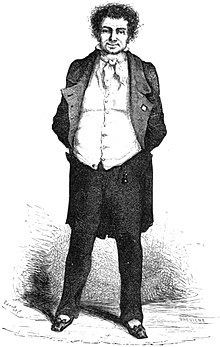
Cesar Birotteau – commentary
Structure
The structure of the novel could not be more simple – or more dramatic. This is reflected in its full title, which is Histoire de la grandeur et decadence de Cesar Birotteau – History of the rise and fall of Cesar Birotteau.
Part I covers Birotteau’s commercial rise – the success of his perfume business, his election to deputy mayor, and the expansion of his property in Paris. But embedded within all this success there are some over-confident financial investments and rash dealings with shady speculators, including the notary Roguin. This part of the novel culminates in the expensive grand ball to which he invites all his influential associates.
Part II plots his downfall – beginning a week after the ball when the bills must be paid. The corrupt notary Roguin absconds with his clients’ money, which precipitates Birotteau into a cascade of debt. He tries to raise money from various bankers without success, and is finally declared bankrupt. He takes a menial job (as do his wife and daughter) and they eventually scrape enough to pay off part of the debt. His former assistant Popinot eventually pays the rest and marries his daughter Cesarine. But Birotteau is overcome by the emotional strain and the reversal in his fortunes, and he dies at the wedding party.
Thus Part I of the novel concludes with Birotteau at the height of his success with a lavish party. Part II echoes this event, with Birotteau having repaid his debts and recovered his honour, with another party celebrating his daughter’s marriage. But Birotteau is worn out with worry and emotional strain – and he dies. The symmetry and the dramatic trajectory of rise and fall are striking.
The financial theme
Part I shows how easy it is, following a modest commercial success, to become drawn into an ever more extravagant style of living. This seductive process is compounded by two further evils of economic life. The first is spending money which has not yet been earned. The second is speculating in schemes over which one has no financial control and which have a high factor of risk, such as gambling on the stock exchange or speculating on the value of real estate.
Part II reveals how difficult it is to recover from a financial disaster. First Balzac outlines in great detail the workings of the law relating to bankruptcy – and in particular how the creditors can stack the odds in their own favour, even to the extent of creating ‘false creditors’. Second, he dramatises quite relentlessly how bankers can control the availability of credit through self-interested networking. Finally he shows the life-sapping efforts necessary to repay debts through the medium of hard work.
Balzac was well aware of all these forces – because he had first-hand knowledge of them. He borrowed money, enjoyed a lavish life-style, and invested in rash speculative ventures which collapsed. He was declared bankrupt, and worked his way out of debt by colossal efforts of literary industry – which eventually killed him at the age of fifty-two. You could almost say that Cesar Birotteau was a prophetic account of his own life story – since he overworked himself to get out of debt, married late, and died shortly afterwards.
La Comedie Humaine
In common with many of the other novels and stories which make up Balzac’s grand vision of French society, Cesar Birotteau features characters who crop up in other works. They might be simply named en passant such as the money-lender Gobseck and the judge Camusot, or they might play a substantial role such as the banker Nucingen and the travelling salesman Gaudissart.
The connections between these named characters and their recurrence in various works is one of the things that gives La Comedie Humaine its spectacular social depth.
Anselme Popinot, the modest and club-footed assistant to Birotteau, is the nephew of Jean-Jules Popinot, who is initially in charge of investigating the court case featured in A Commission in Lunacy.
Sarah Gobseck appears as la belle Hollandaise, the prostitute and mistress of the notary Roguin. She is the grand-niece of the money-lender Jean-Esther Gobseck and the mother of Esther Gobseck who becomes mistress to Lucien Rubempre – both of whom feature in Gobseck and Scenes from a Courtesan’s Life.
Maxim de Trailles crops up in a role he frequently occupies in https://mantex.co.uk/la-comedie-humaine/La Comedie Humaine. He is a rake and a compulsive gambler who is helping to ruin Sarah Gobseck, as he does Anastasie de Restaud in Old Goriot.
Gaudissart the boastful salesman who boosts the sales of Popinot’s hair restorer Cephalic Oil features in a number of later works. He goes on to become the owner of a boulevard theatre and is a key figure in Cousin Pons.
The wealthy banker Frederic Nucingen appears in several novels in La Comedie Humaine, particularly the important volumes Old Goriot, Lost Illusions, and Cousin Bette. His mistress is Esther Gobseck (daughter of Sarah) and his wife Delphine becomes the long-term lover of Eugene de Rastignac.
Balzac – selected reading
The best current editions of the major novels are those published in the Oxford World’s Classics paperback series. Each volume contains a critical introduction, a note on the text, a bibliography of further reading, a biographical chronology of Honore de Balzac, and most importantly a series of explanatory notes giving historical, geographical, and scientific information about details mentioned in the text.
Cesar Birotteau – Penguin Classics – Amazon UK
Pere Goriot – Oxford Classics – Amazon UK
Eugenie Grandet – Oxford Classics – Amazon UK
Cousin Bette – Oxford Classics – Amazon UK
Ursule Mirouet – Penguin Classics – Amazon UK
Selected Stories – NYRB – Amazon UK
Cambridge Companion to Balzac – Cambridge UP – Amazon UK
Cesar Birotteau – plot summary
I Having been made deputy mayor, Cesar Birotteau’s ambition is inflamed. He wants to expand his business and put on a social show, whilst his wife Constance urges caution and restraint. He plans to borrow money to invest in a dubious real estate scheme. He also claims to have discovered a cure for baldness.
II Birotteau has arrived in Paris from Tours. Apprenticed to perfumier Rogon, he learns the details of the trade and during the Revolution becomes an ardent Royalist. He rises to the position of head clerk and dreams only of quiet retirement to Chinon. He falls in love with attractive shop girl Constance and marries her in 1800.
Birotteau buys the perfume business from Rogon and moves to a more fashionable location. He ‘invents’ skin creams ‘Double Paste of Sultan’ and ‘Carminative Balm’. Constance advises him to distribute wholesale at a discount. The business prospers and expands. Birotteau is successful but uneducated. He takes on commonplace ideas and dotes on his daughter Cesarine.
Birotteau employs as chief clerk the ambitious and unscrupulous Ferdinand du Tillet, who tries to seduce Constance. He is dismissed, but steals money from the shop. Tillet then sets himself up as a man of means and becomes a stockbroker then a banker.
III The notary Roguin has impoverished himself by keeping la belle Hollondaise (Sarah Gobseck) as mistress. He has also misappropriated the funds of his clients. Du Tillet persuades him to ‘borrow’ more and invest them secretly in a speculative scheme involving land in the Madeleine district. He persuades Roguin’s mistress and Mme Roguin to do the same. Mme Roguin at this point also becomes du Tillet’s lover.
Du Tillet makes money and influential contacts. But Sarah Gobseck loses money to pay the gambling debts of her lover Maxime de Trailles. Du Tillet invents a scheme to use money from Birotteau and Claparon, a ‘straw man’ whom he recruits. Birotteau proposes to set up young Popinot in a shop to sell his new hair restorer.
IV Birotteau goes ahead with plans to extend his home into the neighbour’s house. He negotiates an agreement with the obsessive landlord Molineux. He orders the nuts for producing the hair-restoring oil, ‘Comagene Essence’.
V Birotteau discusses the Madeleine land project with his uncle Pillerault who has also invested. He checks with scientist Vauquelin that the oil will be good for the scalp. Preparations are made for the house extension and the launch of the second shop.
VI Popinot engages the services of Gaudissart to promote the new hair oil, now called ‘Cephalic Oil’. There is a dinner for the Madeleine investors, joined by du Tillet’s straw man Claparon, who is a sham operating out of his social depth. Meanwhile there is also a dinner to celebrate the launch of Popinot’s hair oil. Judge Popinot arrives to take his young nephew to draw up legal papers.
VII Birotteau extends the guest list of his grand ball to include lots of dignitaries. The apartments are given an expensive refurbishment. The grand ball is an extravagant success. But there are hints of problems to come.
Part II
I A week later Birotteau feels burdened by debt and uncertainty as the bills for his expansion start to arrive. His promissory notes are being refused, and he has no ready cash. The young notary Crottat breaks the bad news. Roguin has held the Madeleine scheme finances without giving receipts. He has squandered the money and disappeared. Sarah Gobseck’s furniture has been sequestered and she has been assassinated. Birotteau has a breakdown, during which time he is visited by Claparon, demanding money for the Madeleine scheme.
II Birotteau seeks help from his uncle and his lawyer, but the case is hopeless. Meanwhile Cephalic Oil is a success and Finot works as a tireless publicist, placing adverts in the press. Birotteau seeks credit from the lofty banker Keller, who refers him to his business-man brother, who wants to see the deeds of the Madeleine scheme.
III The Kellers refuse credit, but du Tillet lends him money, with the malign intention of ruining his former boss. He also gives him a false letter of recommendation to the banker Nucingen. Birotteau reveals his plight to Constance, who supports him.
IV Birotteau appeals to Nucingen, who flatters him, but refers him back to du Tillet. When du Tillet refuses, Birotteau applies to the phoney banker Claparon, who is no use either. Even young Popinot refuses to help him – on the advice of his uncle the judge.
V Popinot reverses his decision, but Pellerault says it is too late because Birotteau’s public reputation is now ruined. Birotteau’s brother the priest responds, but with only a thousand Francs. Pellerault and Popinot make one last attempt to raise the money, but it fails. Birotteau is forced to declare himself bankrupt and he resigns his position as deputy mayor. Constance then applies to Royalist connections, securing jobs for her husband and daughter. She is employed by Popinot. Birotteau accepts his downfall.
VI Balzac explains the tangled web of influences and procedures that obtain in Parisian bankruptcy cases. Birotteau is examined by Molineux but protected by Pellerault. All Birotteau’s assets are sold off and the creditors receive almost sixty percent of their claims. Birotteau, his wife, and his daughter work tirelessly to pay off the rest of the debt.
VII Eighteen months later Birotteau is able to make a partial payment to his creditors. Du Tillet is forced to pay a high price for land that Popinot owns. Constance reveals du Tillet’s original theft and burns his love letters to her. Popinot then pays off the remainder of the debt and restores the Birotteaus to their former home. Birotteau re-visits the Bourse in triumph, having cleared his name. He returns to his old home at the wedding celebrations of Popinot and Cesarine – but the emotional strain is too much for him and he dies of a broken heart.
Cesar Birotteau – characters
| Cesar Birotteau | Parisian perfumier, deputy mayor and Royalist |
| Constance Birotteau | his attractive and loyal wife |
| Cesarine Birotteau | his pretty daughter |
| Ferdinand du Tillet | Birotteau’s former head clerk who becomes a ‘banker’ |
| Anselme Popinot | Birotteau’s modest club-footed apprentice |
| Roguin | Parisian notary who absconds with clients’ money |
| Mme Roguin | his estranged wife who becomes du Tillet’s lover |
| Sarah Gobseck | la belle Hollandaise, Roguin’s mistress |
| Maxime de Trailles | Sarah Gobseck’s lover, a compulsive gambler |
| Jean-Baptiste Molineux | a mean and monomaniac landlord |
| Claude Pillerault | retired honest ironmonger, uncle to Constance |
| Nicolas Vauquelin | a famous chemist |
| Gaudissart | a successful travelling salesman |
| Charles Claparon | a bogus banker, stooge to du Tillet |
© Roy Johnson 2018
More on Honore de Balzac
More on literary studies
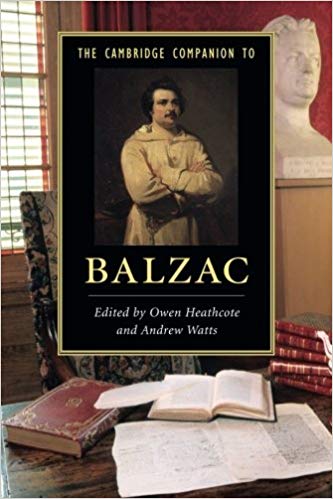
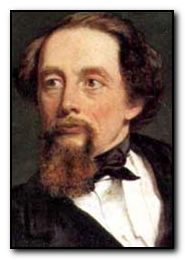 1812. Charles Dickens was born in Portsmouth. His father was a clerk in naval pay office: hard-working but unable to live within income. Several brothers and sisters.
1812. Charles Dickens was born in Portsmouth. His father was a clerk in naval pay office: hard-working but unable to live within income. Several brothers and sisters. The Oxford Companion to Dickens offers in one volume a lively and authoritative compendium of information aboutDickens: his life, his works, his reputation and his cultural context. In addition to entries on his works, his characters, his friends and places mentioned in his works, it includes extensive information about the age in which he lived and worked.These are the people, events and institutions which provided the context for his work; the houses in which he lived; the countries he visited; the ideas he satirized; the circumstances he responded to; and the culture he participated in. The companion thus provides a synthesis of Dickens studies and an accessible range of information.
The Oxford Companion to Dickens offers in one volume a lively and authoritative compendium of information aboutDickens: his life, his works, his reputation and his cultural context. In addition to entries on his works, his characters, his friends and places mentioned in his works, it includes extensive information about the age in which he lived and worked.These are the people, events and institutions which provided the context for his work; the houses in which he lived; the countries he visited; the ideas he satirized; the circumstances he responded to; and the culture he participated in. The companion thus provides a synthesis of Dickens studies and an accessible range of information.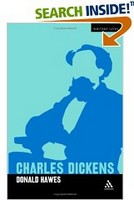
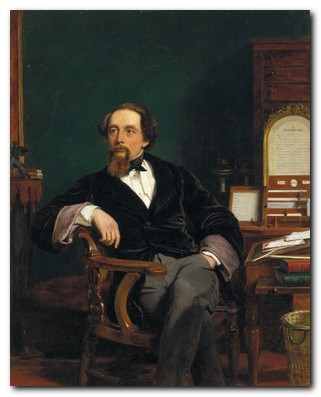
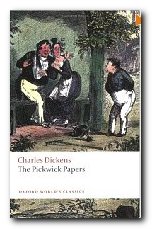 Pickwick Papers (1836-37) was Dickens’ first big popular success, written when he was only twenty-four years old. It was issued in twenty monthly parts and is not so much a novel as a series of loosely linked sketches and changing characters featured in reports to the Pickwick Club. These episodes recount comic excursions to Rochester, Dingley Dell, and Bath; duels and elopements; Christmas festivities; Mr Pickwick inadvertently entering the bedroom of a middle-aged lady at night; and in the end a happy marriage. Much light-hearted fun, and a host of memorable characters.
Pickwick Papers (1836-37) was Dickens’ first big popular success, written when he was only twenty-four years old. It was issued in twenty monthly parts and is not so much a novel as a series of loosely linked sketches and changing characters featured in reports to the Pickwick Club. These episodes recount comic excursions to Rochester, Dingley Dell, and Bath; duels and elopements; Christmas festivities; Mr Pickwick inadvertently entering the bedroom of a middle-aged lady at night; and in the end a happy marriage. Much light-hearted fun, and a host of memorable characters.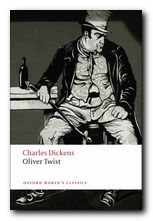 Oliver Twist (1837-38) expresses Dickens’ sense of the vulnerability of children. Oliver is a foundling, raised in a workhouse, who escapes suffering by running off to London. There he falls into the hands of a gang of thieves controlled by the infamous Fagin. He is pursued by the sinister figure of Monks who has secret information about him. The plot centres on the twin issues of personal identity and a secret inheritance (which surface again in Great Expectations). Emigration, prison, and violent death punctuate a cascade of dramatic events. This is the early Victorian novel in fine melodramatic form. Recommended for beginners to Dickens.
Oliver Twist (1837-38) expresses Dickens’ sense of the vulnerability of children. Oliver is a foundling, raised in a workhouse, who escapes suffering by running off to London. There he falls into the hands of a gang of thieves controlled by the infamous Fagin. He is pursued by the sinister figure of Monks who has secret information about him. The plot centres on the twin issues of personal identity and a secret inheritance (which surface again in Great Expectations). Emigration, prison, and violent death punctuate a cascade of dramatic events. This is the early Victorian novel in fine melodramatic form. Recommended for beginners to Dickens.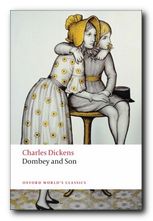 Dombey and Son (1847-48) is Dickens’ version of the King Lear story, in which Dombey, the proud and successful head of a shipping company, loses his son, wife, and daughter because of neglect and his lack of sympathy towards them. Even his second wife is driven into the arms of his villainous business manager – with disastrous results. Eventually his empire collapses, and he lives on in tragic desolation – until his daughter Florence returns and finds a way back to his heart. This is the first of Dickens’ great and powerful masterpieces.
Dombey and Son (1847-48) is Dickens’ version of the King Lear story, in which Dombey, the proud and successful head of a shipping company, loses his son, wife, and daughter because of neglect and his lack of sympathy towards them. Even his second wife is driven into the arms of his villainous business manager – with disastrous results. Eventually his empire collapses, and he lives on in tragic desolation – until his daughter Florence returns and finds a way back to his heart. This is the first of Dickens’ great and powerful masterpieces.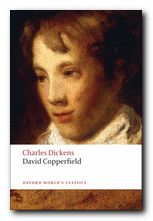 David Copperfield (1849-50) is a thinly veiled autobiography, of which Dickens said ‘Of all my books, I like this the best’. As a child David suffers the loss of both his father and mother. He endures bullying at school and a life of poverty when he goes to work. The book is packed with memorable characters such as Mr Micawber, the fawning Uriah Heep, and the earth-mother figure Clara Peggotty. The plot involves Dickens’ recurrent topics of thwarted romance, financial insecurity and misdoings, and the terrible force of the legal system which haunted him all his life.
David Copperfield (1849-50) is a thinly veiled autobiography, of which Dickens said ‘Of all my books, I like this the best’. As a child David suffers the loss of both his father and mother. He endures bullying at school and a life of poverty when he goes to work. The book is packed with memorable characters such as Mr Micawber, the fawning Uriah Heep, and the earth-mother figure Clara Peggotty. The plot involves Dickens’ recurrent topics of thwarted romance, financial insecurity and misdoings, and the terrible force of the legal system which haunted him all his life.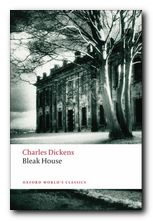 Bleak House (1852-53) is a powerful critique of the legal system. Characters waiting to gain their inheritance from a will which is the subject of a long-running court case are ruined when the delays and costs of the case swallow up the whole estate. At the same time, Ester Summerson, one of Dickens’ most saintly heroines, is surrounded by mystery regarding her parentage and pressure to marry a man she respects but does not love. Unraveling the mystery results in scandal and deaths. Many memorable characters, including ace sleuth Inspector Bucket; Horace Skimpole a criminally irresponsible house guest; and Krook – the ‘chancellor’ of the rag and bone department, who dies from spontaneous combustion – something which Dickens actually believed could happen.
Bleak House (1852-53) is a powerful critique of the legal system. Characters waiting to gain their inheritance from a will which is the subject of a long-running court case are ruined when the delays and costs of the case swallow up the whole estate. At the same time, Ester Summerson, one of Dickens’ most saintly heroines, is surrounded by mystery regarding her parentage and pressure to marry a man she respects but does not love. Unraveling the mystery results in scandal and deaths. Many memorable characters, including ace sleuth Inspector Bucket; Horace Skimpole a criminally irresponsible house guest; and Krook – the ‘chancellor’ of the rag and bone department, who dies from spontaneous combustion – something which Dickens actually believed could happen.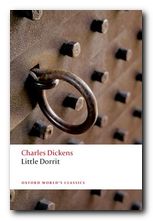 Little Dorrit (1855-57) features Dickens’ recurrent themes of prison, debt, and the negative effects of wealth. William Dorrit and his daughter Amy have been paupers for so long that they actually live in the Marshalsea debtor’s prison. When he is suddenly released because of an inheritance, his place is taken by the middle-aged hero Arthur Clenham when he falls on hard times. Amy is devoted to them both. There is also a murky sub-plot involving doubtful parentage, a mysterious secret, and a villain with two names. Also includes a satirical critique of nineteenth century government bureaucracy in his depiction of the Circumlocution Office. Another of the greatest of Dickens’ works.
Little Dorrit (1855-57) features Dickens’ recurrent themes of prison, debt, and the negative effects of wealth. William Dorrit and his daughter Amy have been paupers for so long that they actually live in the Marshalsea debtor’s prison. When he is suddenly released because of an inheritance, his place is taken by the middle-aged hero Arthur Clenham when he falls on hard times. Amy is devoted to them both. There is also a murky sub-plot involving doubtful parentage, a mysterious secret, and a villain with two names. Also includes a satirical critique of nineteenth century government bureaucracy in his depiction of the Circumlocution Office. Another of the greatest of Dickens’ works.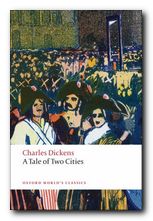 A Tale of Two Cities (1859) was Dickens’ account of the French Revolution – with the story switching between London and Paris. It views the causes and effects of the Revolution from an essentially private point of view, showing how personal experience relates to public history. The characters are fictional, and their political activity is minimal, yet all are drawn towards the Paris of the Terror, and all become caught up in its web of suffering and human sacrifice. The novel features the famous scene in which wastrel barrister Sydney Carton redeems himself by smuggling the hero out of prison and taking his place on the scaffold. The novel ends with the memorable lines: “It is a far, far better thing that I do, than I have ever done; it is a far, far better rest that I go to, than I have ever known.”
A Tale of Two Cities (1859) was Dickens’ account of the French Revolution – with the story switching between London and Paris. It views the causes and effects of the Revolution from an essentially private point of view, showing how personal experience relates to public history. The characters are fictional, and their political activity is minimal, yet all are drawn towards the Paris of the Terror, and all become caught up in its web of suffering and human sacrifice. The novel features the famous scene in which wastrel barrister Sydney Carton redeems himself by smuggling the hero out of prison and taking his place on the scaffold. The novel ends with the memorable lines: “It is a far, far better thing that I do, than I have ever done; it is a far, far better rest that I go to, than I have ever known.”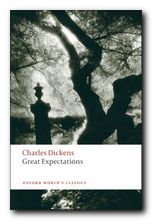 Great Expectations (1860-61) traces the adventures and moral development of the young hero Pip as he rises from humble beginnings in a village blacksmith’s. Eventually, via good connections and a secret benefactor, he becomes a gentleman in fashionable London – but loses his way morally in the process and disowns his family. Fortunately he is surrounded by good and loyal friends who help him to redeem himself. Plenty of drama is provided by a spectacular fire, a strange quasi-sexual attack, and the chase of an escaped convict on the river Thames. There are a number of strange psycho-sexual features to the characters and events, and the novel has two subtly different endings – both adding ambiguity to the love interest between Pip and the beautiful Stella.
Great Expectations (1860-61) traces the adventures and moral development of the young hero Pip as he rises from humble beginnings in a village blacksmith’s. Eventually, via good connections and a secret benefactor, he becomes a gentleman in fashionable London – but loses his way morally in the process and disowns his family. Fortunately he is surrounded by good and loyal friends who help him to redeem himself. Plenty of drama is provided by a spectacular fire, a strange quasi-sexual attack, and the chase of an escaped convict on the river Thames. There are a number of strange psycho-sexual features to the characters and events, and the novel has two subtly different endings – both adding ambiguity to the love interest between Pip and the beautiful Stella.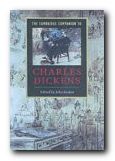 The Cambridge Companion to Charles Dickens contains fourteen essays which cover the whole range of Dickens’s writing, from Sketches by Boz through to The Mystery of Edwin Drood. Some address important thematic topics: childhood, the city, and domestic ideology. Others consider the serial publication and Dickens’s distinctive use of language. Three final chapters examine Dickens in relation to work in other media: illustration, theatre, and film. The volume as a whole offers a valuable introduction to Dickens for students and general readers, as well as fresh insights, informed by recent critical theory.
The Cambridge Companion to Charles Dickens contains fourteen essays which cover the whole range of Dickens’s writing, from Sketches by Boz through to The Mystery of Edwin Drood. Some address important thematic topics: childhood, the city, and domestic ideology. Others consider the serial publication and Dickens’s distinctive use of language. Three final chapters examine Dickens in relation to work in other media: illustration, theatre, and film. The volume as a whole offers a valuable introduction to Dickens for students and general readers, as well as fresh insights, informed by recent critical theory.
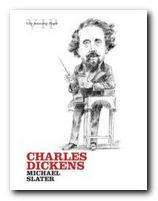
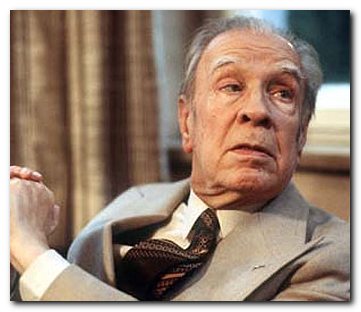
 This is the first of two close reading tutorials on Conrad’s early tale An Outpost of Progress. This one looks at the opening of the story and examines the semantic values transmitted in Conrad’s presentation of the narrative. That is, how the meaning(s) of the story are embedded in even the smallest details of of the prose.
This is the first of two close reading tutorials on Conrad’s early tale An Outpost of Progress. This one looks at the opening of the story and examines the semantic values transmitted in Conrad’s presentation of the narrative. That is, how the meaning(s) of the story are embedded in even the smallest details of of the prose.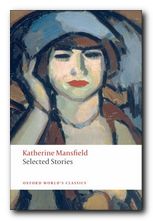 This tutorial looks at one of the opening paragraphs of Katherine Mansfield’s short story The Voyage. It covers the standard features of a writer’s prose style – in the use of vocabulary, syntax, rhythm, tone, narrative mode, and figures of speech; but then it singles out the crucial issue of point of view for special attention. Mansfield was one of the only writers to establish a first-rate world literary reputation on the production of short stories alone.
This tutorial looks at one of the opening paragraphs of Katherine Mansfield’s short story The Voyage. It covers the standard features of a writer’s prose style – in the use of vocabulary, syntax, rhythm, tone, narrative mode, and figures of speech; but then it singles out the crucial issue of point of view for special attention. Mansfield was one of the only writers to establish a first-rate world literary reputation on the production of short stories alone. Virginia Woolf used the short story as an experimental platform on which to test out her innovations in language and fictional narrative. This tutorial offers a detailed reading of the whole of the experimental story Monday or Tuesday. It shows how its mixture of lyrical images, speculative thoughts, and fragments of story-line add up to more than the sum of its parts.
Virginia Woolf used the short story as an experimental platform on which to test out her innovations in language and fictional narrative. This tutorial offers a detailed reading of the whole of the experimental story Monday or Tuesday. It shows how its mixture of lyrical images, speculative thoughts, and fragments of story-line add up to more than the sum of its parts.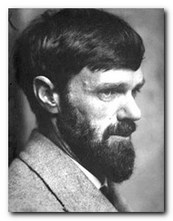 D.H.Lawrence was the first world-class writer to have emerged from the working class. His work was passionate, sensual, and controversial. This tutorial looks at the opening paragraphs of his short story Fanny and Annie published in 1922. It considers in particular his use of the rhetorical devices of repetition and alliteration to impart a poetic impressionism to his writing.
D.H.Lawrence was the first world-class writer to have emerged from the working class. His work was passionate, sensual, and controversial. This tutorial looks at the opening paragraphs of his short story Fanny and Annie published in 1922. It considers in particular his use of the rhetorical devices of repetition and alliteration to impart a poetic impressionism to his writing.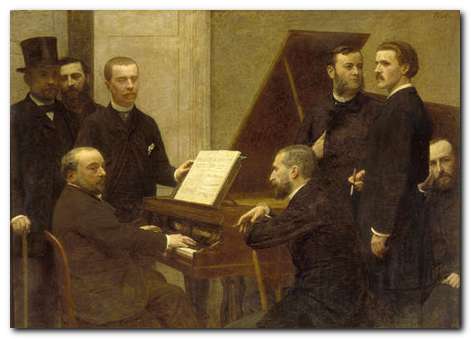

 Daisy Miller
Daisy Miller The Aspern Papers
The Aspern Papers